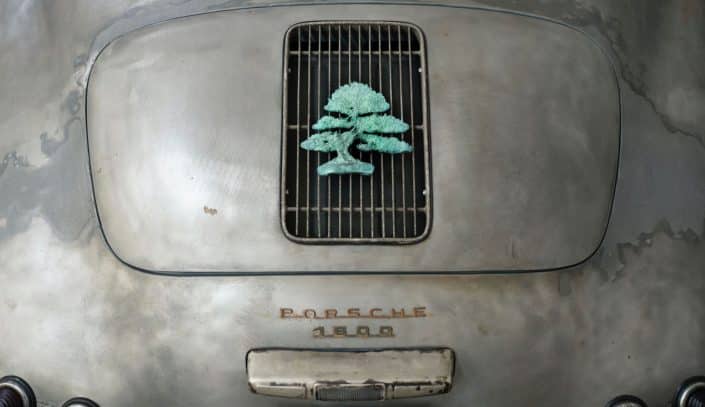En el lapso de dos años, Arsham tomó medidas para revelar la edad y el desgaste del vehículo, apoyándose en la historia de producción del automóvil, inspirado por la reverencia de Arsham hacia la cultura japonesa y sus muchos artesanos especializados. La aceptación de la ‘imperfección’ y la búsqueda de la paz en los procesos naturales del tiempo se manifiestan tanto en el exterior de metal en bruto despojado como en el interior teñido de añil del 356 Bonsai.

Para el exterior del 356, Arsham ha quitado toda la pintura del auto, quitando el acabado original y años de restauraciones, revelando todas las soldaduras, marcas de hoyos y el desgaste natural a lo largo del tiempo. Ahora, solo una capa de aceite de linaza protege el metal en bruto de los elementos, de acuerdo con los procesos de fabricación japoneses originales. En la parrilla trasera del motor del vehículo, Arsham ha añadido un relieve de bronce patinado en forma de bonsái. Sin embargo, el exterior patinado no se detiene en la carrocería, ya que el artista también encontró componentes totalmente originales muy desgastados para el resto del exterior, desde las cubiertas de los faros hasta la placa de matrícula antigua.
Aunque el exterior del automóvil puede parecer desgastado, el 356 Bonsai es completamente manejable, con todos los componentes relacionados con la función, incluido el motor numerado original, que se restauraron al nivel original de fábrica. Para los trabajos técnicos, Arsham colaboró con Willhoit Auto Restoration y Bridgehampton Motoring Club.

“El 356 se encuentra en una posición tan interesante dentro del catálogo de Porsche como punto de partida para la marca tradicional”, dice Arsham. “El vehículo de casi 70 años contiene las raíces de la moderna marca Porsche que conocemos y amamos en la forma más pura”.
Textiles ricos en tradición y antiguas técnicas de elaboración
Arsham reflexiona: “A lo largo de mi carrera, he mirado a Japón como una fuente de inspiración por su amor y dedicación a la artesanía. Estas sensibilidades fueron la base para el Bonsai 356. Producimos todos los textiles en Japón usando artesanos tradicionales”.
Para el interior del vehículo, el artista trabajó junto con los diseñadores de moda japoneses Motofumi ‘Poggy’ Kogi y Yutaka Fujihara para equipar todo el interior con telas japonesas tradicionales, desde patchwork de boro hasta denim de orillo japonés. Para el asiento del conductor y del pasajero, junto con la cubierta del maletero, estos están hechos de textiles patchwork de boro teñidos de añil. Originalmente, esta técnica de reparación japonesa se utilizó para extender la calidad y la durabilidad de las prendas, adoptando el desgaste natural de la ropa de trabajo local. Junto al boro, Arsham agregó más tela de algodón teñida de índigo puntuada con líneas cosidas con sashiko en el borde de la puerta y el borde de los asientos. Como tela final, Arsham y su equipo produjeron una mezclilla japonesa para tapizar el techo y cubrir el interior del automóvil. Estos tres tejidos se unen para realzar la influencia de Wabi Sabi en el coche en su conjunto, eligiendo selectivamente materiales destinados a progresar con el uso y el tiempo.
En el maletero, un tatami japonés se encuentra debajo de la rueda de repuesto en el maletero. Hechas de paja de arroz, estas esteras son un elemento clásico de la arquitectura japonesa y generalmente se colocan como revestimiento de pisos en las áreas de estar. La conexión entre el interior del automóvil y la arquitectura del hogar es un detalle que hace un guiño a la admiración del artista por los omotenashi, como wabi-sabi, mejor experimentado que explicado: calidez y la bienvenida de los invitados en un hogar.
Sobre Daniel Arham
Daniel Arsham nació el 8 de septiembre de 1980 en Cleveland, Ohio y creció en Miami, Florida. Como artista icónico de nuestro tiempo, Arsham da nueva vida a lo cotidiano, experimentando estructuralmente para conectar el pasado, el presente y el futuro en formas inesperadas. Su obra se distingue por cambios sutiles, en particular cuando fusiona objetos para transformar estructuras familiares. El 356 Bonsai es el tercer proyecto de Arsham que involucra un automóvil del fabricante de automóviles deportivos con sede en Zuffenhausen. Porsche Japón planea exhibir el 356 Bonsai en Tokio a finales de año.







